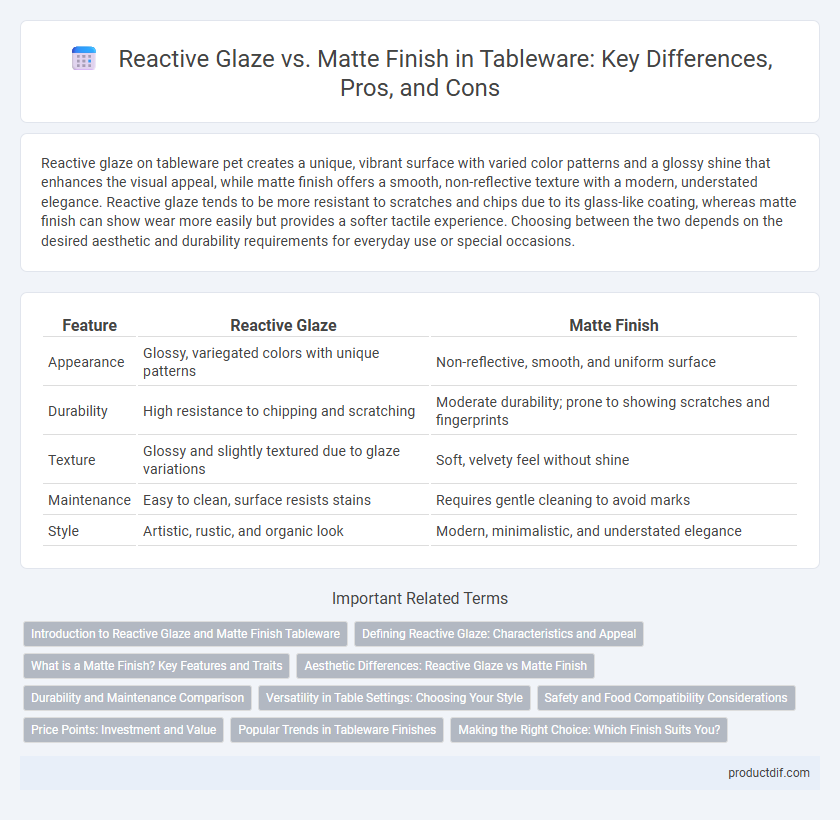Reactive glaze on tableware pet creates a unique, vibrant surface with varied color patterns and a glossy shine that enhances the visual appeal, while matte finish offers a smooth, non-reflective texture with a modern, understated elegance. Reactive glaze tends to be more resistant to scratches and chips due to its glass-like coating, whereas matte finish can show wear more easily but provides a softer tactile experience. Choosing between the two depends on the desired aesthetic and durability requirements for everyday use or special occasions.
Table of Comparison
| Feature | Reactive Glaze | Matte Finish |
|---|---|---|
| Appearance | Glossy, variegated colors with unique patterns | Non-reflective, smooth, and uniform surface |
| Durability | High resistance to chipping and scratching | Moderate durability; prone to showing scratches and fingerprints |
| Texture | Glossy and slightly textured due to glaze variations | Soft, velvety feel without shine |
| Maintenance | Easy to clean, surface resists stains | Requires gentle cleaning to avoid marks |
| Style | Artistic, rustic, and organic look | Modern, minimalistic, and understated elegance |
Introduction to Reactive Glaze and Matte Finish Tableware
Reactive glaze tableware features a unique, variegated surface created through chemical reactions during firing, resulting in unpredictable color variations and a tactile texture. Matte finish tableware offers a smooth, non-reflective surface that enhances a minimalist aesthetic while providing a soft visual appeal. Both finishes influence durability and design, with reactive glaze emphasizing artisanal uniqueness and matte finish promoting modern elegance.
Defining Reactive Glaze: Characteristics and Appeal
Reactive glaze features a dynamic surface characterized by variations in color and texture, created through chemical reactions during the firing process. This finish offers a unique, artisanal appeal with unpredictable patterns and depth that enhance each piece's individuality. Its visually captivating and tactile qualities make it a popular choice for sophisticated, handcrafted tableware.
What is a Matte Finish? Key Features and Traits
A matte finish on tableware features a non-reflective, smooth surface that diffuses light, offering a soft, understated aesthetic ideal for modern and rustic dining settings. This finish resists fingerprints and minor scratches better than glossy surfaces, providing a durable and low-maintenance option for everyday use. Matte tableware often showcases subtle textures and muted tones that enhance the visual appeal without overpowering the food presentation.
Aesthetic Differences: Reactive Glaze vs Matte Finish
Reactive glaze offers a dynamic, variegated surface with rich color depth and organic patterns that create a unique, artisanal look on tableware. Matte finish provides a smooth, non-reflective texture with consistent, muted tones that emphasize minimalism and modern elegance. The choice between reactive glaze and matte finish significantly influences the visual appeal and tactile experience, catering to different aesthetic preferences in tableware design.
Durability and Maintenance Comparison
Reactive glaze tableware offers a unique, artisanal appearance with a durable surface that resists chipping and scratches better than matte finishes. Matte finish tableware, while elegant and modern, tends to show wear more quickly and can be more susceptible to staining and scratches. Maintenance for reactive glaze involves gentle cleaning to preserve the glaze's texture, whereas matte finishes require careful handling to avoid surface dullness and marks over time.
Versatility in Table Settings: Choosing Your Style
Reactive glaze offers a unique, variegated appearance with a glossy surface, enhancing the visual appeal in both casual and formal table settings. Matte finish provides a subdued, non-reflective texture that complements minimalist and rustic styles, adding understated elegance. Selecting between reactive glaze and matte finish depends on desired versatility, with reactive glaze suited for vibrant, dynamic arrangements and matte finish ideal for subtle, sophisticated designs.
Safety and Food Compatibility Considerations
Reactive glaze tableware often undergoes high-temperature firing, creating a durable, non-toxic surface that resists food absorption and is generally safe for daily use. Matte finish ceramics can sometimes be more porous, potentially harboring bacteria if not properly sealed, which may affect food safety and require careful maintenance. Both finishes should comply with FDA or relevant food safety standards to ensure they are lead and cadmium-free, ensuring safe direct contact with food.
Price Points: Investment and Value
Reactive glaze tableware generally commands a higher price point due to the complex firing process and unique, variegated patterns created during production, offering investment in artistry and uniqueness. Matte finish pieces tend to be more affordable, providing value through their minimalist aesthetic and ease of mass production. Buyers seeking exclusivity and collector-worthy items often prefer reactive glaze, while those prioritizing budget-friendly durability opt for matte finish options.
Popular Trends in Tableware Finishes
Reactive glaze offers a unique, variegated surface with dynamic color variations that create an artisanal, handcrafted aesthetic highly sought after in contemporary tableware design. Matte finish, characterized by its smooth, non-reflective texture, provides a modern, understated elegance that complements minimalist and Scandinavian-inspired dining settings. Current trends highlight the increasing preference for reactive glaze in artisanal ceramics, while matte finishes remain popular for stackable and everyday functional dinnerware collections.
Making the Right Choice: Which Finish Suits You?
Reactive glaze creates a unique, variegated surface with depth and subtle color variations, making each piece distinctive and ideal for artistic tableware. Matte finish offers a smooth, non-reflective texture that provides a modern, understated elegance and resists fingerprints and smudges. Choosing between reactive glaze and matte finish depends on whether you prefer a one-of-a-kind, textured appearance or a sleek, minimalist look for your table setting.
Reactive glaze vs Matte finish Infographic

 productdif.com
productdif.com